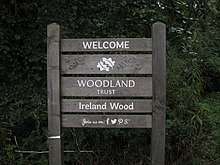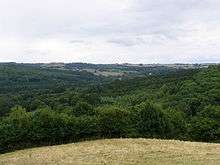Woodland Trust
The Woodland Trust is the largest woodland conservation charity in the United Kingdom concerned with the creation, protection, and restoration of native woodland heritage. It has planted over 43 million trees since 1972.[4]
 | |
| Motto | The voice for trees and woods |
|---|---|
| Formation | 1972 |
| Legal status | Non-profit company and registered charity |
| Purpose | Woodland conservation |
| Location |
|
Region served | UK |
Membership | 250,000[1] |
Chief Executive | Darren Moorcroft[2] |
Main organ | Board of Trustees[3] |
Budget | £48.2 million[1] |
| Website | www.woodlandtrust.org.uk |
The Woodland Trust has three key aims: i) to protect ancient woodland which is rare, unique and irreplaceable, ii) the restoration of damaged ancient woodland, iii) plant native trees and woods with the aim of creating resilient landscapes for people and wildlife.[5]
The Woodland Trust maintains ownership of over 1,000 sites covering over 24,700 hectares (247 km2). Of this, 8,070ha (33%) is ancient woodland.[6]. It ensures public access to its woods.[7]
History

The charity was founded in Devon, England in 1972 by retired farmer and agricultural machinery dealer Kenneth Watkins.[8]
The Trust's first purchase was part of the Avon Valley Woods, near Kingsbridge, Devon.[9] By 1977 it had twenty two woods in six counties. In 1978 it relocated to Grantham in Lincolnshire and announced an expansion of its activities across the UK. In 1984, Balmacaan Wood next to Loch Ness became the Trust's first Scottish acquisition.[10] It has supported the National Tree Week scheme, which takes place in late November and is run by The Tree Council.
From 2005 to 2008 it co-operated with the BBC for their Springwatch programme and the BBC's Breathing Places[11] series of events held at woods. It continues to work with Springwatch and Autumnwatch most recently in 2015 as part of the Big Spring Watch, which encouraged viewers to record the signs of nature (Phenology) through the Trust's Nature's Calendar project.
Sites
- It now has over 80 woods in Scotland, covering 21,000 acres (8,500 ha).[12]
- In Wales, it acquired the 94 acres (38 ha) Coed Lletywalter in Snowdonia National Park in 1980. It now has over 100 woods in Wales.[13]
- It started in Northern Ireland in 1996 when it received a grant from the Millennium Commission to set up over 50 community woods. The scheme was called Woods on Your Doorstep.
Headquarters
Its first employee and Director, John James, came from Lincolnshire and was living in Nottingham at the time.[14] It had a small office on Westgate. John James was Chief Executive from 1992-97, and then Michael Townsend from 1997-2004, Sue Holden from 2004-14 and Beccy Speight from 2014-19. The current Chief Executive is Darren Moorcroft.[2]
A new eco-friendly headquarters, adjacent to the former HQ, was completed in 2010 at a cost of GB£5.1million.[15] The new headquarters have been designed by Feilden Clegg Bradley Studios as Architect and Atelier One as Structural Engineer,[16] and incorporates light shelves to distribute natural daylight around the 200 workstations, and concrete panels to absorb daytime heat, to provide the thermal mass that the lightweight wooden structure would otherwise lack.[17] It is estimated that compared to a concrete framed construction, the timber structure saved the equivalent in carbon production as nine years of the building's operation.[15]
Structure
The Woodland Trust's Head Office is located in Grantham in South Kesteven, south Lincolnshire, with regional offices across the UK.[18] It employs around 300 people at its Grantham headquarters. Its current president is Clive Anderson since 2003. In 2016 Barbara Young, Baroness Young of Old Scone became the charity's Chair.
Funding
The Woodland Trust receives funding from a wide range of sources including membership, legacies, donations and appeals, corporate supporters, grants and charitable trusts including lottery funding, other organisations and landfill tax.[19]
Function
The Woodland Trust uses its experience and authority in conservation to influence others who are in a position to improve the future of native woodland. This includes government, other landowners, and like-minded organisations. It also campaigns to protect and save ancient woodland from destructive development. Its projects also include the Nature Detectives youth programme, a project for schools learning about the seasonal effect on woodlands - phenology - and the Ancient Tree Hunt campaign.
Woodland protection
It looks after more than 1,000 woods[20] and groups of woods covering 190 square kilometres (73 sq mi). Nearly 350 of its sites contain ancient woodland of which 70 per cent is semi-natural ancient woodland – land which has been under tree cover since at least 1600. It also manages over 110 Sites of Special Scientific Interest. There are currently over 600 ancient woods under threat across the UK.
Woodland creation
It has also created new woodlands: over 32 km2 (12 sq mi) have been created, including 250 new community woods in England, Wales and Northern Ireland. Its largest current projects include the 41.7 km2 (16.1 sq mi) Glen Finglas Estate in the Trossachs, Scotland and the Heartwood Forest near St Albans, Hertfordshire, England, which will cover approximately 347 ha (860 acres). It owns 20 sites covering 4.3 km2 (1.7 sq mi) in the National Forest and has twelve sites in Community Forests in England.
The Woodland Trust also provides free trees to communities or places of education in order to facilitate the creation of new woodland.[21][22]
Millennium woods
The Woodland Trust's Woods on Your Doorstep project created 250 "Millennium woods" to celebrate the millennium 2000/2001.[23]
Jubilee woods

The Trust ran the Jubilee Woods project, which aimed to plant 6 million trees and create 60 commemorative 'Diamond' woods across the UK as part of Queen Elizabeth II's Diamond Jubilee celebrations in 2012.[24] The largest of these, owned and managed by the Trust itself, is the Flagship Diamond Wood in Leicestershire. Situated within the National Forest this will be planted with 300,000 trees.[25]
Ancient Tree Inventory
The Ancient Tree Inventory[26] is a project run by the Woodland Trust in partnership with the Tree Register of the British Isles and the Ancient Tree Forum.[27] The aim is to record ancient, veteran and notable trees in the United Kingdom. To date over 170,000 trees have been recorded. The database allows a better understanding of the number and spread of ancient trees in the UK. The records can be viewed through the tree search on the Ancient Tree Inventory website. Anyone can add to the database by recording a tree, records are then verified by a team of volunteers.
First World War Centenary Woods
This is a project commemorating the First World War which involved tree planting and the establishment of new woodland sites across the UK. The planned sites are Langley Vale Wood (England), Dreghorn Woods (Scotland), Coed Ffos Las (Wales), and Brackfield Wood (Northern Ireland).[28]
For Club and Country
As part of its Centenary Woods project the Woodland Trust entered a partnership with the National Football Museum to create team groves to commemorate all the professional football players involved in the First World War, giving supporters the chance to dedicate trees at the English Centenary Wood, Langley Vale in Epsom.[29]
Nature's Calendar
The project encourages members of the public to record the signs of the seasons near to them in order to show and assess the impact of climate change on the UK's wildlife.[30]
There are thousands of volunteers who send in their sightings, providing crucial evidence about how wildlife is responding to the changing climate. This makes it an example of citizen science.
The Trust's records date back to 1736, making it the longest written biological record of its kind.[31] It has become a powerful tool in assessing the impact of climate change and is highly valued by research scientists.
Woods


Woods it owns and looks after include:
England
|
|
Scotland
- Backmuir Wood, Angus
- Glen Finglas Estate - the Trossachs
See also
|
|
References
- Woodland Trust (April 2019). "Report and Accounts 31 December 2018" (PDF). www.woodlandtrust.org.uk. Woodland Trust. Retrieved 26 April 2019.
- https://www.woodlandtrust.org.uk/about-us/our-people/our-chief-executive/
- "Our Trustees". woodlandtrust.org.uk. Retrieved 11 October 2016.
- Woodland Trust. "Support Us". woodlandtrust.org.uk. Retrieved 26 April 2019.
- Woodland Trust. "What We Do". woodlandtrust.org.uk. Retrieved 26 April 2019.
- Woodland Trust. "The current state of ancient woodland restoration" (PDF). woodlandtrust.org.uk. Retrieved 7 January 2020.
- Woodland Trust. "Access to woodland - the Woodland Trust's position". woodlandtrust.org.uk. Retrieved 26 April 2019.
- "Kenneth Watkins - Obituary". The Times. 22 November 1996. p. 25. Retrieved 26 August 2014. – via NewsBank (subscription may be required or content may be available in libraries)
- "Avon Valley Woods". Woodland Trust. Retrieved 31 October 2019.
- The Woodlands Trust (1984). "New Woods" (Newsletter 15). Cite journal requires
|journal=(help) - "Breathing Places". BBC. Retrieved 26 November 2012.
- Woodland Trust. "Where We Work - Scotland". woodlandtrust.org.uk. Retrieved 10 October 2016.
- Woodland Trust. "Where We Work - Wales". woodlandtrust.org.uk. Retrieved 10 October 2016.
- "About The Woodland Trust". Giving Back. Retrieved 11 October 2016.
- Rattenbury, Kester (28 October 2010). "Woodland Trust HQ, Grantham, by Feilden Clegg Bradley Studios | Building study". Architects Journal. Retrieved 26 November 2012.
- "Solutions Sustainability: Newsletter" (PDF). Klhuk.com. Retrieved 26 November 2012.
- "Woodland Trust HQ | Engineering Projects". Max Fordham. 26 March 2010. Retrieved 26 November 2012.
- Woodland Trust. "Our Locations". woodlandtrust.org.uk. Retrieved 10 October 2016.
- Woodland Trust. "How We Are Funded - Annual Reviews". woodlandtrust.org.uk. Retrieved 10 October 2016.
- Woodland Trust. "How We Are Run". woodlandtrust.org.uk. Retrieved 11 October 2016.
- "Grantham charity offer schools the chance to 'green-up' with free trees". Grantham Journal. Retrieved 11 October 2016.
- Bateman, Stephanie. "Plant free trees in Sheffield with help from the Woodland Trust". The Star. Retrieved 11 October 2016.
- Powell Ettinger (13 September 2010). "Wildlife Extra News - Ten years on and 250 Millennium woods transform Britain's landscape". Wildlifeextra.com. Retrieved 5 April 2014.
- "Celebrate Queen Elizabeth's historic Diamond Jubilee during 2012 with the Woodland Trust". Woodlandtrust.org.uk. Retrieved 7 August 2012.
- Daily Mail Reporter. "The Royal forest: Six million trees and 460-acre 'living legacy' woodland to mark Queen's Diamond Jubilee". Daily Mail. Retrieved 11 October 2016.
- "Welcome to the Ancient Tree Inventory". Ancient Tree Inventory. Retrieved 31 July 2018.
- "Ancient Tree Forum". Ancient Tree Forum. Retrieved 31 July 2018.
- Woodland Trust. "First World War Centenary Woods". woodlandtrust.org.uk. Retrieved 10 October 2016.
- Woodland Trust. "For Club and Country - Remembering the Greater Game". forclubandcountry.org.uk. Retrieved 10 October 2016.
- Woodland Trust. "The Nature's Calendar Survey". naturescalendar.org.uk. Retrieved 10 October 2016.
- Garforth, Judith. "Nature's Calendar: How your records are used". woodlandtrust.org.uk. Retrieved 11 October 2016.
- "Dick Buck's Burrows woodland" (PDF). The Woodland trust. Retrieved 23 August 2014.
- "Garratts Wood - a Woodland Trust Wood". Woodland Trust. Retrieved 2 August 2012.
- "Great Wood – Felbrigg Estate". Details of Great Wood – Felbrigg. The Woodland Trust. Retrieved 23 August 2014.
- "Hackfall Woods". visitharrogate.co.uk. Visit Harrogate. Retrieved 6 January 2020.
- "Natural England - SSSIs : SSSI information". Sssi.naturalengland.org.uk. 1 November 2012. Retrieved 26 November 2012.
- "Pretty Corner Wood" (PDF). Information Leaflet about the woodland. Woodland Trust – North Norfolk Council. Retrieved 23 August 2014.
- "Warren Wood – Cromer". Details of Warren Wood near Cromer, Norfolk. The Woodland Trust. Retrieved 23 August 2014.
- "Weybourne Wood". Details of Weybourne Wood near Weybourne Norfolk. The Woodland Trust. Retrieved 23 August 2014.
- "West Runton Wood". Details of West Runton Wood. The Woodland Trust. Retrieved 23 August 2014.
- Devine, Darren. "The spectacular Welsh rainforest bought for £1m for the nation thanks to a major bequest". Wales Online. Retrieved 11 October 2016.
- "Coed Ffos Las". gov.wales. Retrieved 11 October 2016.
- "Brackfield Wood, Northern Ireland". woodlandtrust.org.uk. Retrieved 11 October 2016.
- "Monkstown Wood". woodlandtrust.org.uk. Retrieved 11 October 2016.
External links
| Wikimedia Commons has media related to Woodland Trust. |